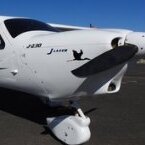PA180-180A - If I dump from 40 deg flap in the Archer in the go around (say from baulked landing) , then I only go to 25 deg of flap in the go around- until I am well and truly estabilished on climb, and my brain has caught up with the airplane ..... situation understood, and flying in balance....... IE full power, trim, reduce from 40 to 25 flap when stabilized over run way, then climb, retrim to reduce stick pressure, stabilize, then reduce flap as required .... She climbs very well at 25 (which is the book specificed short field TO flap), no need to dump the whole lot (which reduces all sorts of margins) .
This minimises the trim changes, gets altitude, and minimises airspeed requirements, since there is a hefty change in minimum flying speed going from 25 to 10. WOnt climb much faster than half way between Vx and Vy with 25 flap. You cant get much speed with 25 flap. From a baulked landing where you might be getting very slow in ground effect (so likely below book full flap stall) , there is no room for error at that juncture ! But that proceedure ----- NOT for HOT, WINDY, HEAVY. see below.


